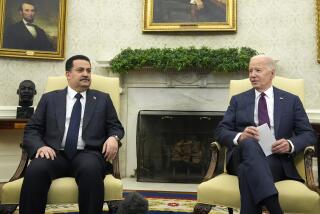Yemen protests swell as 180,000 join rallies nationwide
Protests in Yemen mushroomed Friday into the largest pro-democracy demonstrations in the nation’s history, as more than 180,000 people marched in streets and squares calling for the ouster of longtime President Ali Abdullah Saleh.
About 30,000 anti-government protesters, 10 times as many as have gathered in recent days, convened in front of Sana University here in Yemen’s capital in peaceful, joyful demonstrations. More than 150,000 others convened in other cities and provinces across Yemen, according to local news reports.
The protests in Yemen were the largest on a “day of rage” across the Arab world Friday. Hundreds of thousands of protesters took to the streets in Jordan, Bahrain, Iraq and Algeria. Even in Tunisia and Egypt, which have already seen longtime leaders fall, people were out in force, demanding accountability from their new governments.
In Sana, the mood near the university was markedly different Friday from that of the last week, in part because of the surge of tens of thousands of people and the diversity they brought to the two-week-old protests.
“Look around; these are not just students, not just young people,” said Khaled Anesi, a human rights lawyer and activist. “There are tribesmen, people from the south, professionals, everybody. Together, we will take down this regime.”
Anti-Saleh protesters have set up more than a 100 brightly colored camping and wedding tents in the intersection in front of the university, which has become the epicenter of dissent. The intersection is decorated with Yemeni flags, banners, signs scrawled with slogans such as “Game over, Saleh” and “Get out, and take your dogs with you,” and photographs of the two young men who were shot to death by pro-Saleh forces Tuesday night.
Meanwhile across town, aobut 10,000 government supporters, some of whom had been bused in from outer provinces, marched in the capital’s Tahrir Square. They were provided flags and placards bearing the president’s picture, and they chanted that Saleh provided stability to the country. A banner hanging over the square read, “Disorder is a Support for Terrorism.”
Near the university, the mood in the center of the so-called Freedom Square was something akin to a festival, with men in traditional tribal dress dancing with college students and schoolchildren, their faces painted with Yemen’s tricolor. But on the edges, where anti-Saleh demonstrators have set up makeshift weapons checks, the atmosphere remained tense.
Two young police officers fired shots into the air to disperse a crowd Friday, setting off a domino effect as officers across the square panicked and also fired shots. A police supervisor rushed to the officers, took their guns and threw them into the back of a truck, defusing the situation.
The moment underscored how easily violence could break out in one of the most heavily armed nations in the world. A protester was reported killed Friday by government forces in the southern port city of Aden.
Saleh has tried to strike a conciliatory tone, distancing himself from the pro-government forces who have been attacking and shooting at protesters. He called for security officers to give full protection to demonstrators.
“The government of the Republic of Yemen will continue to protect the rights of its citizens to assemble peacefully and their right to freedom of expression,” Saleh said, according to an official news release.
Protesters have been encouraging the tribes, as well as Saleh’s many enemies, to join them in the streets. Houthi rebels in Yemen’s northern provinces, who have been fighting Saleh’s government for six years, announced their support for the protesters last week and held rallies in Abyan and Saada provinces Friday, attracting tens of thousands of participants, the group reported.
Southern separatist leaders also have announced their support for the anti-Saleh protesters. They joined demonstrations Friday in Abyan and Shabwa provinces, and in Aden, news reports said.
Protesters across the region poured out of Friday prayers and into the streets.
In Cairo, thousands of demonstrators returned to Tahrir Square two weeks after mass protests toppled longtime President Hosni Mubarak and the military high command took control of the Egyptian government.
Many in the crowd complained that Mubarak’s former aides still are running the Justice, Interior, Foreign Affairs and other key ministries, and that only the man at the top had changed.
Edwards is a special correspondent. Times staff writers Jeffrey Fleishman and Bob Drogin in Cairo contributed to this report.
More to Read
Start your day right
Sign up for Essential California for news, features and recommendations from the L.A. Times and beyond in your inbox six days a week.
You may occasionally receive promotional content from the Los Angeles Times.






